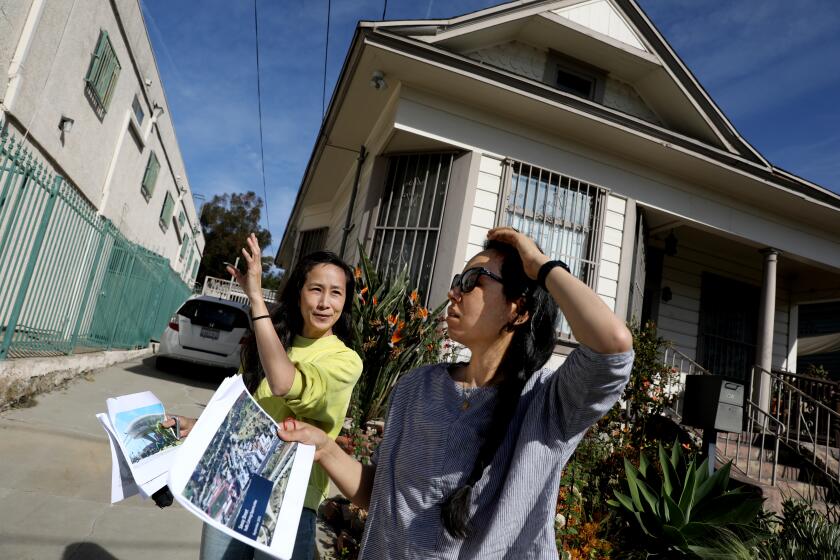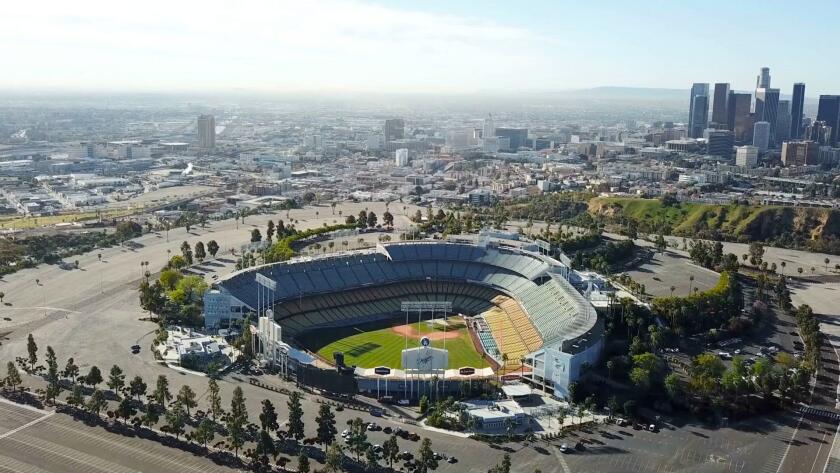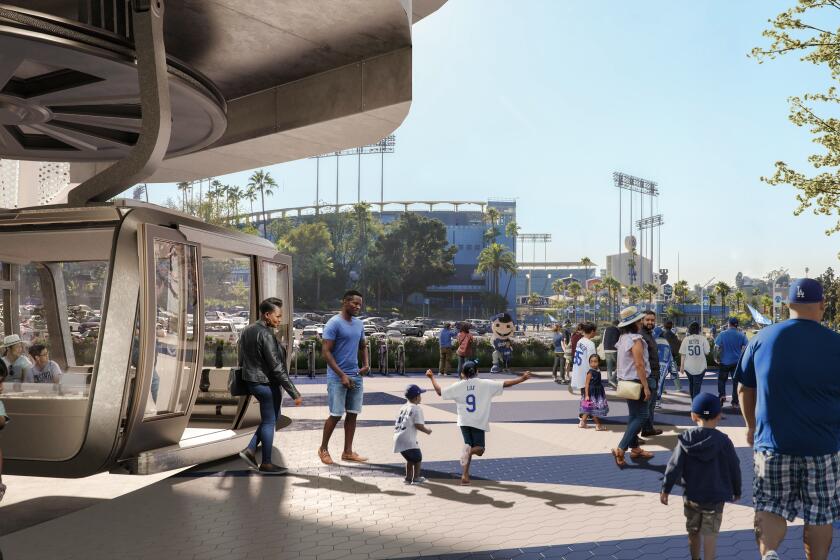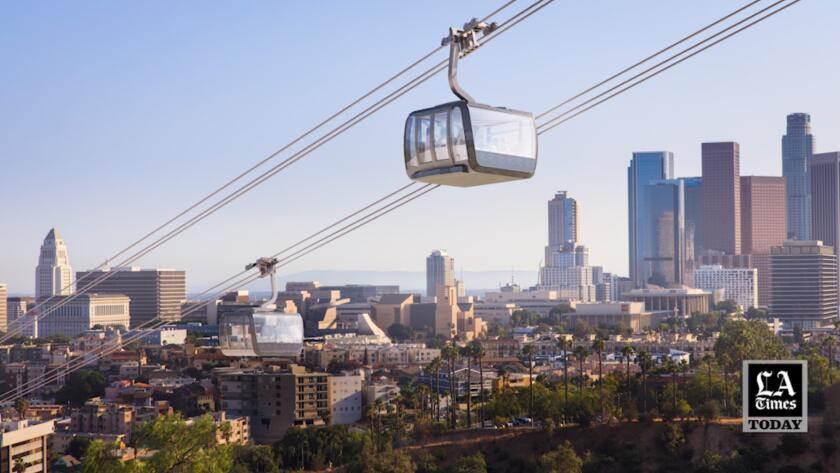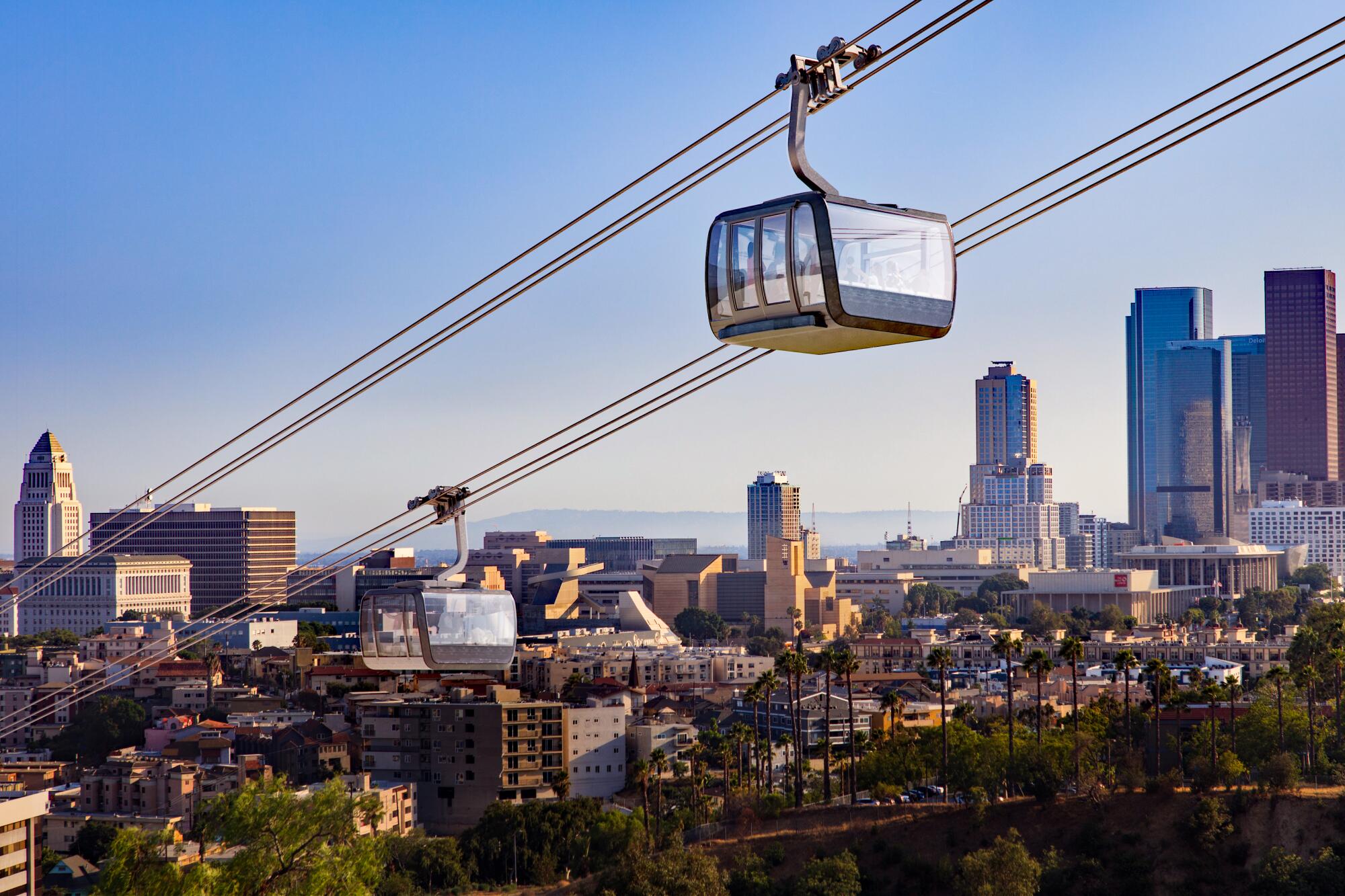
- Share via
It’s almost time for Dodger baseball. You’re rolling west along Sunset Boulevard, visions of Mookie Betts and Clayton Kershaw and Julio Urías happily dancing through your mind.
You’re one block from turning onto Vin Scully Avenue and into Dodger Stadium when you notice a black billboard, looming ominously above an auto repair shop called Fernando’s Tires. The billboard features this name, in bright white letters: Frank McCourt.
That guy?
Yes, that guy, the one who traded two Boston parking lots and what one of his attorneys said was “not a penny” of his own cash for ownership of the Dodgers. Yes, the one who dragged the storied team into bankruptcy amid Major League Baseball allegations he had “looted” $189 million from team revenues for personal use. And, yes, the one who laughed all the way to the bank, selling the Dodgers for a billion-dollar profit in 2012.
He did not, however, sell the parking lots that surround the stadium. In 2018, he pitched a gondola that would transport fans from Union Station to Dodger Stadium.
Five years later, the proposal is still alive, now shepherded by an environmental organization delighted at the prospect of the gondola taking cars off the streets and keeping pollutants out of the air. That Sunset Boulevard billboard and others like it are brought to you by opponents of the gondola, taking aim at the project in part by relentlessly associating it with McCourt.
The aerial gondola proposed for Dodger Stadium sparks fears of accelerated gentrification, and a lawsuit to stop the ‘sweetheart deal.’
The Dodgers are guaranteed to play 81 games at Dodger Stadium every year, with playoff games traditionally added in October and concert dates sprinkled throughout the year. That leaves skeptics within the community to wonder why McCourt would promote a gondola ride to a stadium parking lot that would be empty three out of every four days during the year.
Unless, of course, the lot would not be empty.
McCourt’s company, now known as McCourt Global, highlights this slogan: “Building for tomorrow.” McCourt did not sell the Dodger Stadium parking lots because he anticipated building something there, some day.
What might that be? And is the gondola intended to carry us to that day?
The pursuit of those answers took me to Dodger Stadium, to City Hall and to a meeting of MLB owners. First, however, I stopped at a weathered red brick building in the Arts District, an old furniture and fabric warehouse reimagined as a laboratory for energy innovation.
Three colorful banners greeted visitors, one with the hue of a bright blue sky. “Welcome,” that banner read, “to the Cleantech Future of Power and Water.”
The interior comes alive with vibrancy and urgency, and with work on dozens of concepts. Any one of them, building managers say, could emerge as “the next big idea to fight climate change.”
The Dodger Stadium gondola represents such an idea, according to its proponents. Climate Resolve, a nonprofit based in that building, agreed to take the reins from McCourt in leading the project.
“From my perspective,” said Climate Resolve founder and executive director Jonathan Parfrey, “to have a gondola transporting people from Union Station to Dodger Stadium, and to have that exciting, beautiful conveyance identified as a climate action?
“It changes the way people approach public transit. So it was very attractive to us.”
With baseball’s new hurry-up rules, you could miss half the game if you get stuck in Dodger Stadium’s oft-snarled traffic and get to your seat an hour after the first pitch.
The gondola alternative: get to Union Station, hop aboard a spacious cabin that could arrive every 23 seconds, soar high above the city, and arrive at Dodger Stadium in seven minutes.
The climate benefit is easy to envision: fewer fans in cars powered by gasoline; more fans in gondolas powered by electricity.
- Share via
A promotional video for the proposed Dodger Stadium gondola project released by Los Angeles Aerial Rapid Transit.
The climate downside is easy to envision too: massive development at Dodger Stadium, with neighborhood disruption for years of construction, and with cars converging upon the stadium every day, not just on game days.
“I’m involved in this project,” Parfrey said, “and I brought my organization into this project, predicated on there not being development on that land.”
Not now, or not ever?
“Not for the foreseeable future,” he said.
Parfrey said he had been given “assurances” that the gondola was not a first step toward Dodger Stadium development. I asked who had given him those assurances, or who I could ask to get those same assurances.
“Ask Frank,” he said.
Near Lot G at Dodger Stadium, along the long slog from the outer reaches of the parking lots to a stadium entrance behind left field, a colorful model of a gondola cabin awaits you. You can step inside the 24-seat cabin, then imagine a ride that would allow you to skip traffic to the ballpark and instead, as the signage reads: “GET THERE BY AIR.”
You can even find a helpful decal, showing you where to stand to take a picture with the gondola cabin in the foreground and the stadium in the background.
The display of a model cabin takes a page from the playbook for pitching a new stadium or arena. Models and renderings can excite fans, but they also can obscure a critical question about any big project: Looks cool, but who is going to pay for this?
The cost of building the gondola was estimated at $300 million in 2020 and is expected to rise by the time a financing plan is finalized, said David Grannis of Point C Partners, a transportation and land use consultancy working with Climate Resolve.
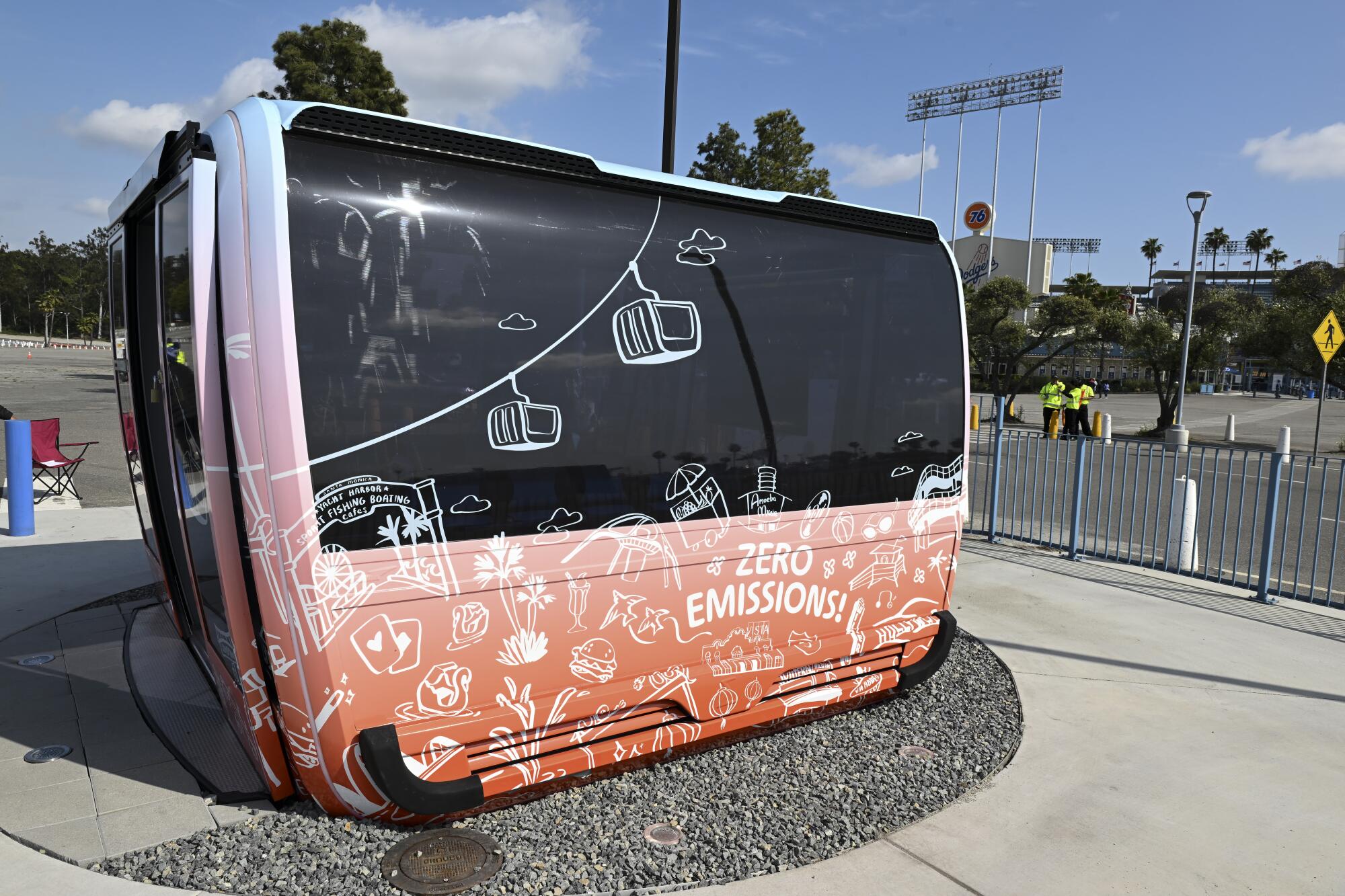
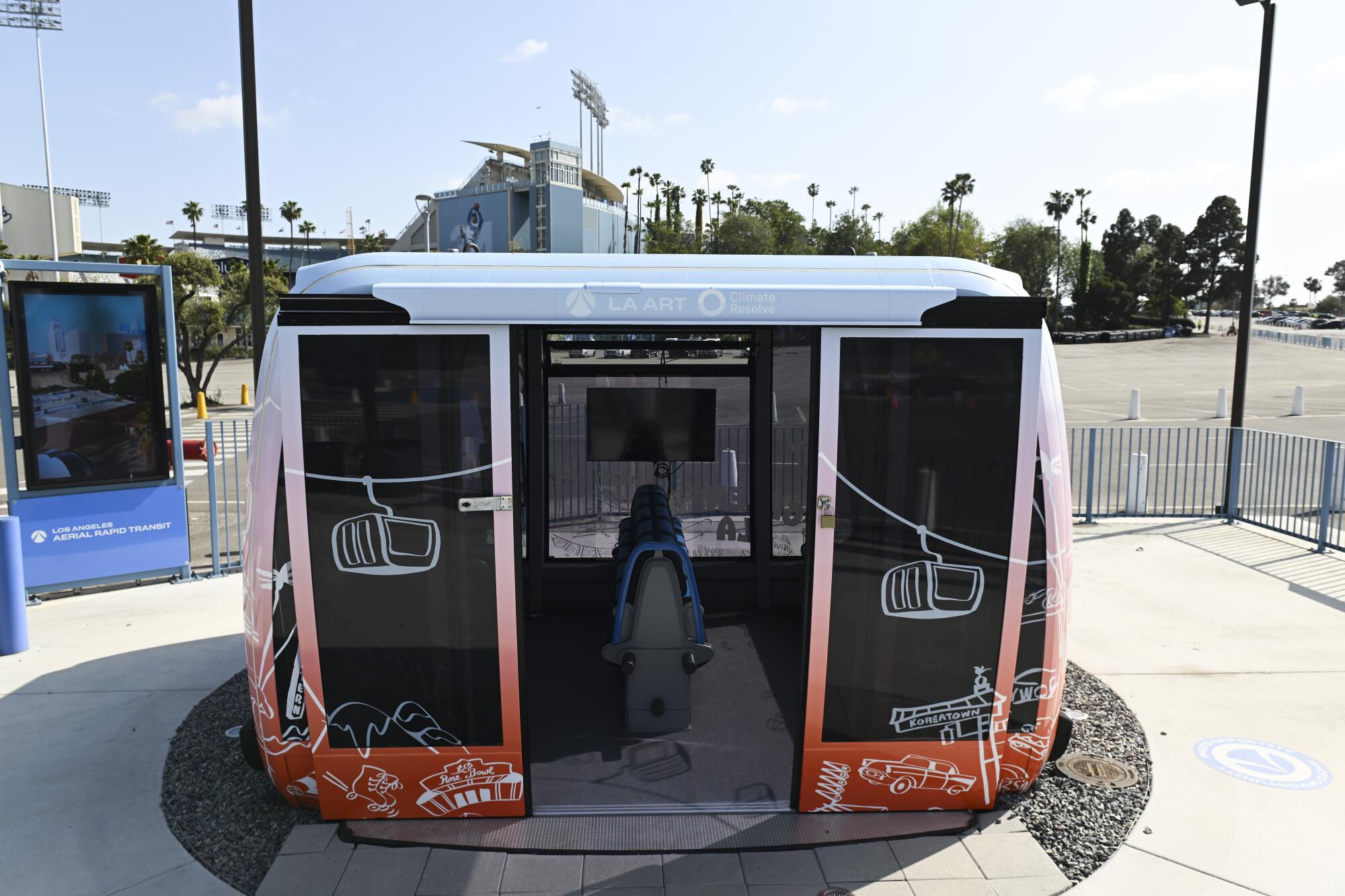
The McCourt entity that originated the gondola concept, LA Aerial Rapid Transit, has agreed to fund the approval process, including environmental studies and permit applications, project spokesman Nathan Click said. It is up to Climate Resolve to figure out how to pay for construction, as well as for annual operating costs Grannis estimated at between $5 million and $10 million.
The gondola won’t make money, at least not under the current plan of free rides for fans with a Dodgers ticket and neighborhood residents with a Metro pass.
Parfrey said taxpayers would not be asked to subsidize the gondola.
The hundreds of millions would come from private financing, Grannis said, and largely from sponsorships and the purchase of naming rights.
In 2012, the airline Emirates agreed to pay about $60 million for a 10-year sponsorship of a London gondola — then called the Emirates Air Line — that carried riders above the River Thames and cost $96 million. The current one-way adult fare on the London gondola is $7.50.
“In this case,” Grannis said, “you have a venue that happens to be the best attended in Major League Baseball, and therefore the iconic nature of this cabin flying to Dodger Stadium and taking you there is going to attract a lot of sponsors, a lot of people who want naming rights or sponsorship.
“That’s the big revenue.”
Jeff Marks, the founder and chief executive of Innovative Partnerships Group, brokers naming rights and sponsorship deals between companies and teams, leagues and venues. He said it “could be doable” to cover the cost of building and operating the gondola through corporate sponsorships, but he said even the most generous sponsor might not be willing to strike a nine-figure deal without exposure beyond simply slapping the company’s name on the side of the gondola.
Marks, speaking generally because he is not involved in the project, said a title sponsor might also want a benefit such as the company name on the field. A hypothetical example: Verizon Field at Dodger Stadium. The Dodgers have hired firms to solicit corporate offers for naming rights to the field and patches on the team jerseys.
Or, Marks said, a primary sponsor might prefer naming rights to whatever development might rise atop the parking lots: Take the Verizon Gondola to the Verizon Village at Dodger Stadium!
Rick Caruso, the developer behind the Grove and Americana shopping and entertainment centers, pursued the Dodgers when McCourt put them up for sale. Caruso commissioned studies on how to improve the notorious congestion for cars getting into and out of the Dodger Stadium parking lots.
Without control of the lots, however, Caruso believed he might not have been able to implement any changes. McCourt insisted he would not sell the lots, and Caruso withdrew from the bidding.
Guggenheim Baseball Management, the winning bidder, took a different approach. Guggenheim, led by Mark Walter and Stan Kasten, bought the Dodgers and their stadium from McCourt. In a separate transaction, a Guggenheim entity formed a joint venture with a McCourt entity to control the parking lots.
In land use documents filed by the joint venture in 2012 and intended to “facilitate the orderly development” of the Dodger Stadium parking lots, the potential property uses cited include homes, offices, restaurants, shops, entertainment venues, medical and academic buildings, a separate sports facility and a hotel and exhibit hall.
“It is an ill-conceived concept that the highest and best use of Chavez Ravine is 260 acres for parking,” an attorney for McCourt, Tony Natsis, said at the time. “I consider that to be an ill-conceived notion for the owner of the parking lots and the owner of the stadium.”
Walter, the Dodgers’ chairman and controlling owner, said McCourt cannot develop anything on the property without Guggenheim’s consent. What might Walter be thinking in terms of development now?
“I haven’t been thinking about it at all,” Walter said.
A Dodger stadium gondola could be built by 2028 Olympics; however, the proposal just lost its biggest backer, and it’s unclear if Mayor Karen Bass supports the project.
Kasten, the Dodgers’ president and chief executive, said the Dodgers support the gondola project but are “really not involved” in it. Walter had a simple explanation for why the Dodgers would back a project that would chew up a chunk of the parking lots in the stadium.
“Hopefully, it will make it easier for people to get there,” he said.
Of the 18,889 parking spaces at the stadium, the gondola station at Dodger Stadium would result in the loss of 194 spaces, according to the environmental impact report for the project.
To the Dodgers, that would not be a big deal. But this might be: The report projects 10,000 people would ride the gondola to each game by 2042, which could translate to a loss of about 20% of parking revenue.
Kasten called those figures “hypotheticals that I don’t have an answer for,” and project opponents dismissed the ridership projections as unrealistically high, citing a UCLA study.
But a person familiar with the Dodgers’ business model, speaking on condition of anonymity so as not to jeopardize his professional relationships, said the team likely would not agree to give up millions in annual parking fees without some way to recoup that money.
“It does not make sense for the Dodgers to do it if they’re going to lose parking revenue,” the person said. “It does make sense if the gondola is serving a larger development.”
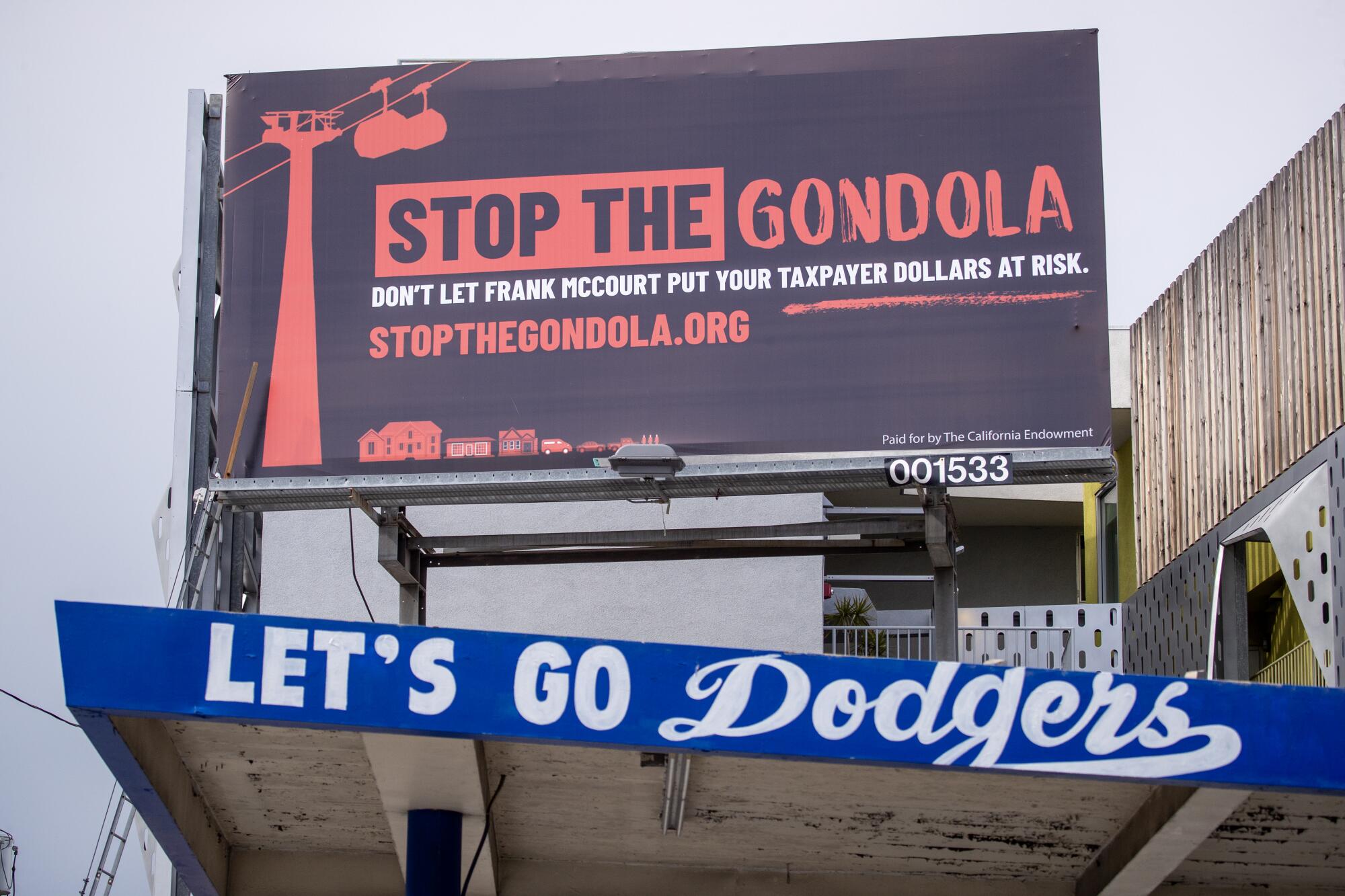
The California Endowment, a nonprofit with offices that would sit beneath the shadow of a 195-foot gondola tower, is leading and largely funding a coalition opposing the project. In court papers, the Endowment cited the Dodger Stadium development proposal McCourt unveiled when he owned the team and alleged the gondola would be “a loss leader for the future development of parking lots at Dodger Stadium.”
What would Kasten say to Angelenos who would like to know whether the gondola comes first and development comes next?
“That’s a question you’ll have to address to someone else,” Kasten said.
To the people proposing the gondola?
“Yes,” Kasten said. “That’s where I would direct my questions.”
I had. And what had I been told? Ask Frank.
On April 9, 2021, for the first time in 32 years, the Dodgers raised a World Series championship banner. The Dodgers bestowed the honor of hoisting the treasured flag upon five people, including three of their own: Dodgers co-owners Magic Johnson and Billie Jean King, each decorated champions in their own right, and Hall of Fame broadcaster Jaime Jarrín.
The other two: Eric Garcetti, then the mayor of Los Angeles, and Gil Cedillo, then the city councilman representing the district that includes Dodger Stadium.
The Dodgers forged a strong working relationship with Cedillo. The team and nine of its senior executives combined to make $13,800 in campaign contributions to him from 2013 to ‘22, according to city records.
Cedillo lost his bid for re-election last year, defeated by community activist Eunisses Hernandez. Kasten and Hernandez each expressed a desire to work together for the benefit of the fans and the community.
Garcetti, who has backed the gondola from the time McCourt first pitched it five years ago, said the Dodgers never have hinted to him that mass development would be in the works at Dodger Stadium.
“I think there is a vision of trying to make it less of a once- or twice-a-year kind of a place for a family, when you go to a game,” Garcetti said before he left office last December, “and more of an asset: the best view in L.A., a place for more special events, a place where baseball history can be celebrated.
“I think their core business is baseball, and they want to protect that.”

The environmental impact report does not contemplate development at Dodger Stadium. The report states “no housing units are proposed” as part of the project and “additional approvals requiring further environmental review would be necessary” for any development at the stadium or elsewhere along the gondola route.
For Hernandez, that language is not enough. The councilwoman said she has “a lot of concerns” about the gondola.
“I am not convinced that this is an effective solution to reducing vehicle congestion,” she said, “and I share the neighborhood’s concerns about displacement and disruption.”
Hernandez said she is not necessarily opposed to development at Dodger Stadium, provided affordable housing is a priority. She is opposed to considering the gondola on its own, without any consideration of whether development might follow and what it might involve.
“I don’t think it’s appropriate to undertake such large-scale projects without a full and clear understanding of long-term plans,” Hernandez said. “This shouldn’t be piecemealed out, and I want to see additional development plans made clear.
“That is the honest approach, and that’s what will allow the community, the city, and all involved entities to make a clear-eyed decision.”
Steve Soboroff, who was the mayoral point man on the construction of Staples Center and later president of the Playa Vista development near LAX, worked briefly with McCourt in the final year of his Dodgers ownership.
Soboroff is not involved in the gondola project. He said the most effective way to build community support for the project would be to offer transparency about the long-term plan, even if the gondola would come first and any development would come later.
“That would be the path that I would choose,” Soboroff said.
It was time for me to do what Parfrey had suggested: Ask Frank.
The Dodgers have prospered without McCourt, and McCourt has prospered without the Dodgers.
He bought the storied French soccer club Olympique de Marseille. He donated $200 million to what is now called the McCourt School of Public Policy at Georgetown University. He launched Project Liberty, an initiative to reform the Internet in the interest of serving “people, not platforms.”
As McCourt told Leaders Magazine: “Our technology today is great if you want to support autocracy, but it is not so great if you want to support individual rights and the freedoms and liberties assorted with democracy.”
McCourt still owns the Los Angeles Marathon, which starts at Dodger Stadium. During the past two months, as Urbanize LA reported, McCourt entities revealed plans to construct 502 apartments in three buildings on two sites along Stadium Way and another one block south, overlooking the 110 Freeway. The apartment buildings are planned regardless of whether the gondola is approved, said Brin Frazier, a spokeswoman for McCourt.
The applicant for the apartment projects is listed in city records as Jordan Lang, president of two McCourt entities: McCourt Partners Real Estate and Aerial Rapid Transit Technologies.
Lang’s company biography makes no mention of any experience in other transportation projects but touts his leadership in completing “millions of square feet of office, hotel, residential and mixed-use projects.”
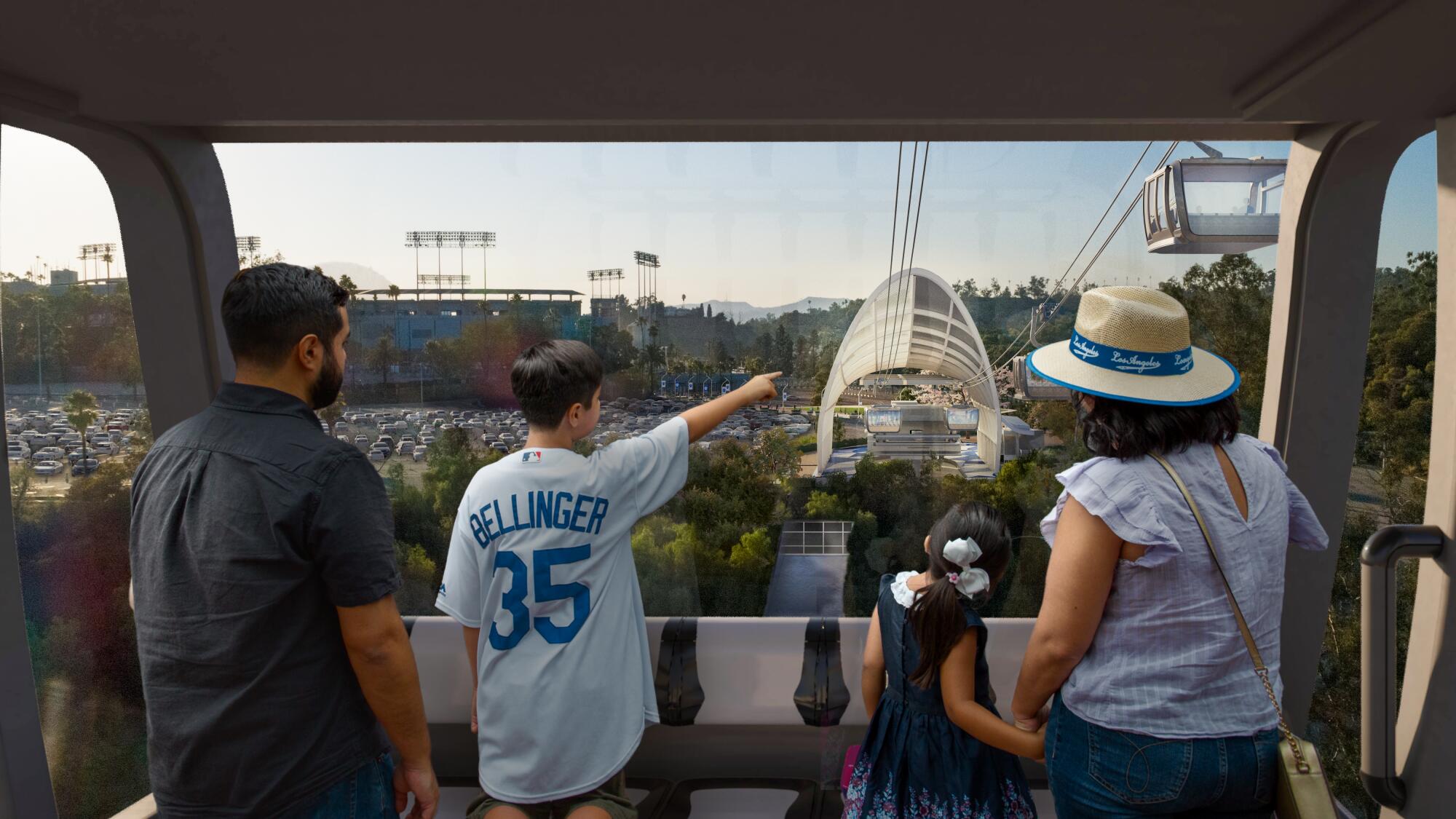
The prospect of developing such a large site on the outskirts of downtown is so rare that the city’s movers and shakers have floated concepts for decades. Caruso and I talked about some of them 18 years ago, long before McCourt put the team up for sale or Caruso ran unsuccessfully for mayor.
Peter O’Malley, the revered former Dodgers owner, proposed building an NFL stadium in the Dodger Stadium parking lot in 1995. McCourt revived the idea in 2005.
The other four MLB teams in California all have pursued mixed-use developments surrounding their ballparks. The Angels’ most recent proposal — since killed by the city of Anaheim amid a corruption scandal — would have included more than 5,000 homes on a site roughly half the size of the Dodger Stadium property.
“We need more housing,” Garcetti said. “We need it to be centrally located. We need it to be affordable. I think, if you meet those criteria, you can start a conversation with the city.”
Or, perhaps, development at Dodger Stadium could mean a selection of food halls, restaurants and bars, enticing enough to lure fans to arrive long before the game and stick around after it ends. That in itself could ease the neighborhood traffic bottlenecks on game days, gondola or no gondola.
Parfrey, who said his nonprofit agreed to take the lead on the gondola project based on what he said was a promise of no development on the land, said his organization would not support a ballpark neighborhood arising on the property but would support a plan to put a restaurant here and there within the parking lot.
“We would go early and go to the restaurants,” Parfrey said.
Parfrey, remember, was the guy who told me to “ask Frank” about the “assurances” that the arrival of the gondola would not trigger development. I mentioned that to Frazier, McCourt’s spokeswoman, and asked if I could speak to him about that.
“Frank,” she said, “is not available.”
- Share via
Watch L.A. Times Today at 7 p.m. on Spectrum News 1 on Channel 1 or live stream on the Spectrum News App. Palos Verdes Peninsula and Orange County viewers can watch on Cox Systems on channel 99.
More to Read
Sign up for This Evening's Big Stories
Catch up on the day with the 7 biggest L.A. Times stories in your inbox every weekday evening.
You may occasionally receive promotional content from the Los Angeles Times.

